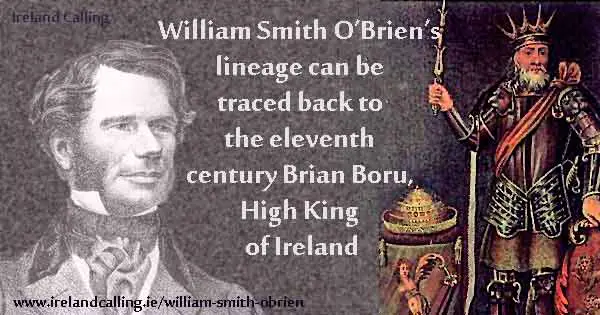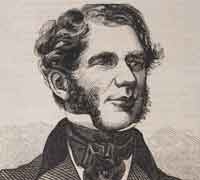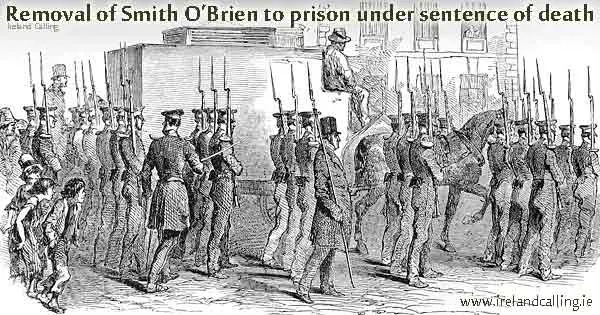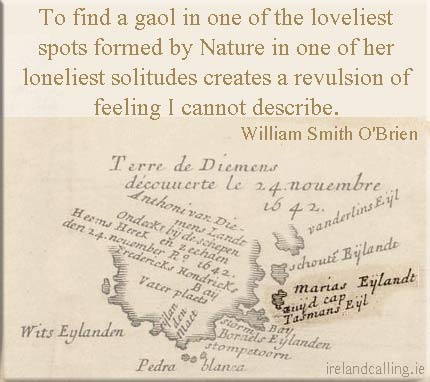William Smith O’Brien was one of the leading lights of Irish nationalism in the 19th century.
He was sentenced to death for his part in the Young Irelander rebellion of 1848 but this was later reduced to transportation from Ireland.
He managed to return years later and helped to revive the ancient Celtic culture and promote the use of the Irish language.

Smith O’Brien was born on 17 October 1803 in Dromoland, County Clare. His father was of Sir Edward O’Brien, 4th Baronet, of Dromoland Castle. When his mother died and left him property, he began using her maiden name ‘Smith’ as an extra surname. His lineage can be traced back to the eleventh century Brian Boru (High King of Ireland).

Politics
He became a Tory Member of Parliament (MP) in the British parliament for Ennis (1828 to 1831), and then for Limerick County (1935 to 1848). He was leader of the Young Ireland movement.
Fight for Catholic emancipation
In Great Britain and Ireland in the late 18th century and early 19th century, Catholic Emancipation aimed to reduce lots of the limitations placed on Roman Catholics which were began with the Act of Uniformity, the Test Acts and the penal laws. Roman Catholics were expected to renounce the spiritual authority of the pope and transubstantiation.
O’Brien was Protestant, but he supported Catholic Emancipation (or Catholic relief), while continuing to support British-Irish union.
In 1843, he joined the anti-union Repeal Association founded by Daniel O’Connell, in protest against the imprisonment of O’Connell. However, in 1846, O’Brien withdrew the Young Irelanders from the Repeal Association when he became dissatisfied with O’Connell.
O’Brien and the Young Irelanders
In January 1847 he founded the Irish Confederation with Thomas Francis Meagher. A year later, in March 1848, he spoke in support of a National Guard and tried to initiate a national uprising on 29 July 1848. O’Brien and the Young Irelanders led landlords and tenants in a rebellion in just three counties, battling against police at Ballingarry, County Tipperary (there were only few casualties).
Sentenced to be hung, drawn, and quartered
He was tried for sedition and found guilty of high treason on May 15 1848, for his involvement of the Young Irelander Rebellion of 1848. He was sentenced to be hung, drawn, and quartered.

There was an outcry and 70,000 people in Ireland and 10,000 people in England signed petitions for clemency.
He sentence was commuted and O’Brien and fellow Young Irelanders were deported, for life, to Van Diemen’s Land (part of present day Australia).

After five years, he was released in 1854, and he lived in Brussels for two years. The conditions of his release were that he remain exiled from Ireland. However, in 1856 O’Brien was pardoned and was able to return to Ireland. He wasn’t involved in politics on his return to Ireland.
Promoting the Irish language
His sister, Harriet O’Brien, founded the order of Anglican nuns in Clewer, Windsor, in 1851. The gold cross she wore, and which still belongs to the Community, was made with gold panned by her brother during his exile in Australia.
O’Brien was a founding member of The Ossianic Society which was founded on St Patrick’s Day 1853. It was an Irish literary society and took its name from the ancient narrator Oisín.
The aim of the society was to encourage the use of the Irish language – it translated and published the Irish and Scottish mythology stories of the Fenian Cycle with mythical hero Fionn mac Cumhaill (Finn McCool) and his warriors the Fianna.
In 1863, on his recommendation, Irish was introduced into a number of schools in Clare (irish speaking regions of Ireland at the time).
There is a statue of him on O’Connell Street, Dublin.
history.html
